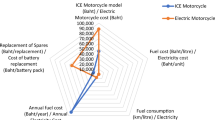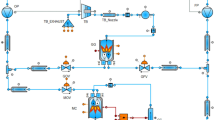Abstract
Fuel injection timing is an important control parameter for engine combustion optimization and emissions control. However, the actual fuel injection timing is different from the nominal one commanded by the electronic control unit, due to the system hydraulic lag or the possible communication malfunction. In this study, a simple estimate approach based on the injector inlet pressure is proposed to capture four critical characteristic instants at the start and end of injection. The critical characteristic moments estimated using this pressure-based approach are validated against those determined by the actual injection rate profiles, in the context of different single or split injection processes. The comparison revealed that the characteristic injection moments estimated by the injector inlet pressures and those determined by the actual injection rate profiles have a satisfactory agreement, certifying the broad applicability and reliability of this pressure-based approach in the detection of the real fuel injection start and end time.
Similar content being viewed by others
References
MOHAN B, YANG W M, CHOU S K. Fuel injection strategies for performance improvement and emissions reduction in compression ignition engines—A review [J]. Renewable & Sustainable Energy Reviews, 2013, 28: 664–676.
LI T, MORIWAKI R, OGAWA H, et al. Dependence of premixed low-temperature diesel combustion on fuel ignitability and volatility [J]. International Journal of Engine Research, 2012, 13(1): 14–27.
HAN D, ICKES A M, BOHAC S V, et al. HC and CO emissions of premixed low-temperature combustion fueled by blends of diesel and gasoline [J]. Fuel, 2012, 99: 13–19.
JING W, WU Z Y, ROBERTS W L, et al. Spray combustion of biomass-based renewable diesel fuel using multiple injection strategy in a constant volume combustion chamber [J]. Fuel, 2016, 181: 718–728.
YANAI T, AVERSA C, DEV S, et al. Investigation of fuel injection strategies for direct injection of neat n-butanol in a compression ignition engine [J]. SAE International Journal of Engines, 2016, 9(3): 1512–1525.
CATANIA A E, FERRARI A, MANNO M. Development and application of a complete common-rail injection system mathematical model for hydrodynamic analysis and diagnostics [C]//ASME Internal Combustion Engine Division Spring Technical Conference. Chicago, USA: American Society of Mechanical Engineers, 2005.
PLAMONDON E, SEERS P. Development of a simplified dynamic model for a piezoelectric injector using multiple injection strategies with biodiesel/diesel-fuel blends [J]. Applied Energy, 2014, 131: 411–424.
PAYRI R, SALVADOR F J, MARTÍ-ALDARAVÍ P, et al. Using one-dimensional modeling to analyse the influence of the use of biodiesels on the dynamic behavior of solenoid-operated injectors in common rail systems: Detailed injection system model [J]. Energy Conversion & Management, 2012, 54(1): 90–99.
D’AMBROSIO S, FERRARI A. Effects of pilot injection parameters on low temperature combustion diesel engines equipped with solenoid injectors featuring conventional and rate-shaped main injection [J]. Energy Conversion & Management, 2016, 110: 457–468.
D’AMBROSIO S, FERRARI A. Effects of exhaust gas recirculation in diesel engines featuring late PCCI type combustion strategies [J]. Energy Conversion & Management, 2015, 105(2): 1269–1280.
BUSCH S, ZHA K, WAREY A, et al. On the reduction of combustion noise by a close-coupled pilot injection in a small-bore direct-injection diesel engine [J]. Journal of Engineering for Gas Turbines and Power, 2016, 138(10): 102804.
LI T, SUZUKI M, OGAWA H. Effect of two-stage injection on unburned hydrocarbon and carbon monoxide emissions in smokeless low-temperature diesel combustion with ultra-high exhaust gas recirculation [J]. International Journal of Engine Research, 2010, 11(5): 345–354.
REHMAN S. Sensors based measurement techniques of fuel injection and ignition characteristics of diesel sprays in DI combustion system [J]. Alexandria Engineering Journal, 2016, 55(3): 2391–2402.
SEQUERA A J, PARTHASARATHY R N, GOLLAHALLI S R. Effect of fuel injection timing in the combustion of biofuels in a diesel engine [C]//International Energy Conversion Engineering Conference. Denver, USA: AIAA, 2013.
MARCHI A, NOURI J, YAN Y, et al. Spray stability of outwards opening pintle injectors for stratified direct injection spark ignition engine operation [J]. International Journal of Engine Research, 2010, 11(6): 413–437.
HAN D, DUAN Y Z, WANG C H, et al. Experimental study on injection characteristics of fatty acid esters on a diesel engine common rail system [J]. Fuel, 2014, 123: 19–25.
HAN D, WANG C H, DUAN Y Z, et al. An experimental study of injection and spray characteristics of diesel and gasoline blends on a common rail injection system [J]. Energy, 2014, 75: 513–519.
CATANIA A E, FERRARI A, MANNO M, et al. Experimental investigation of dynamics effects on multiple-injection common rail system performance [J]. Journal of Engineering for Gas Turbines and Power, 2008, 130(3): 032806.
HAN D, DUAN Y Z, WANG C H, et al. Experimental study of the two-stage injection process of fatty acid esters on a common rail injection system [J]. Fuel, 2016, 163: 214–222.
HAN D, LI K, DUAN Y Z, et al. Numerical study on fuel physical effects on the split injection processes on a common rail injection system [J]. Energy Conversion & Management, 2017, 134: 47–58.
Author information
Authors and Affiliations
Corresponding author
Additional information
Foundation item: the National Natural Science Foundation of China (No. 51306114)
Rights and permissions
About this article
Cite this article
Zhai, J., Duan, Y. & Han, D. Pressure-Based Approach to Estimating the Injection Start and End in Single and Split Common Rail Injection Processes. J. Shanghai Jiaotong Univ. (Sci.) 23 (Suppl 1), 28–33 (2018). https://doi.org/10.1007/s12204-018-2019-5
Received:
Published:
Issue Date:
DOI: https://doi.org/10.1007/s12204-018-2019-5
Key words
- injector inlet pressure
- common rail injection system
- injection diagnostics
- single injection
- split injection




